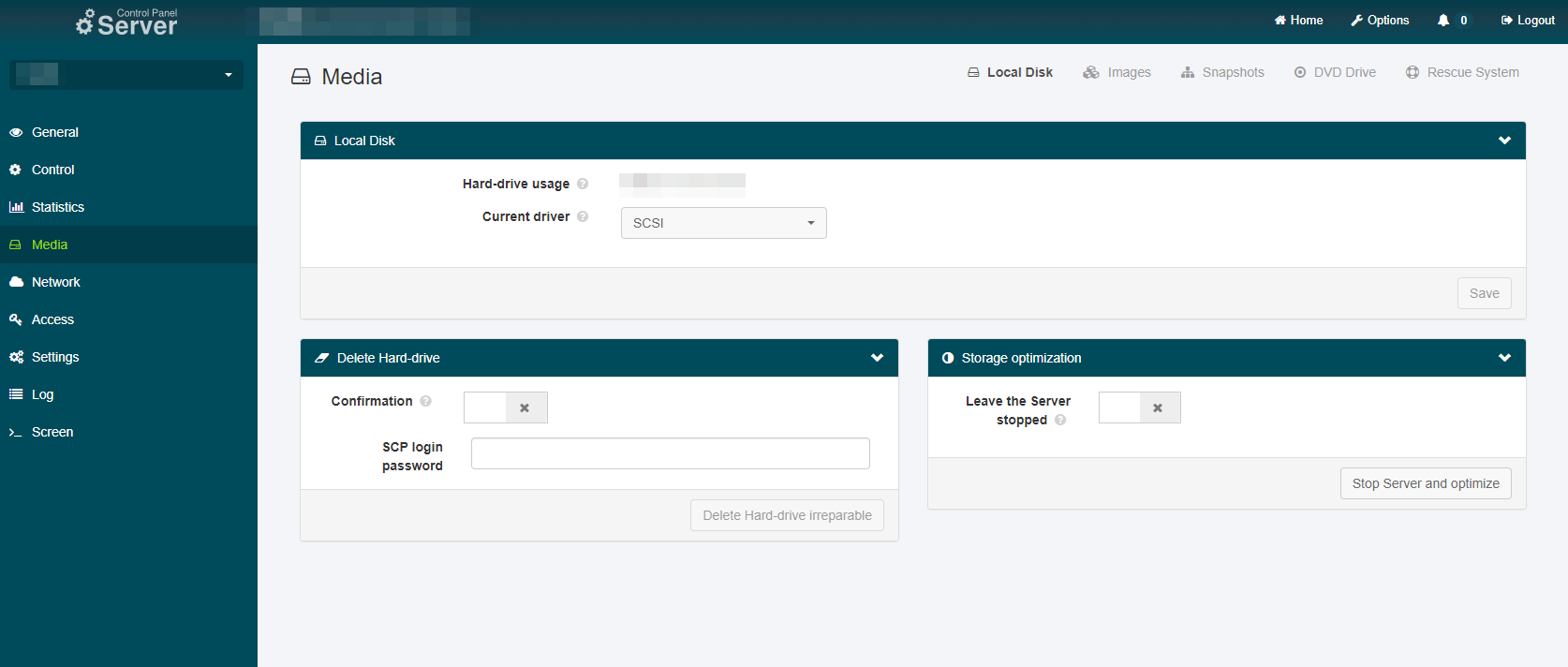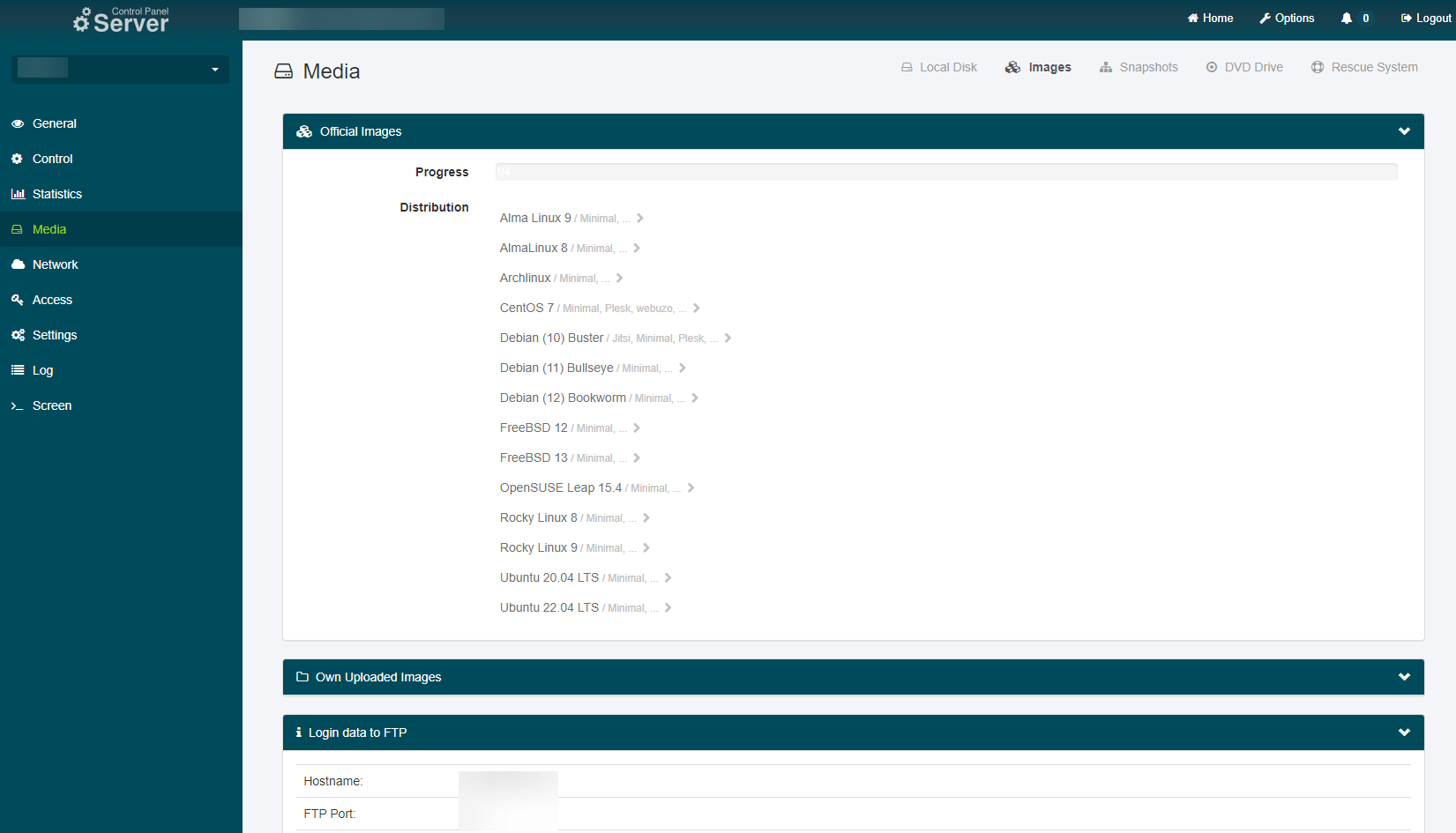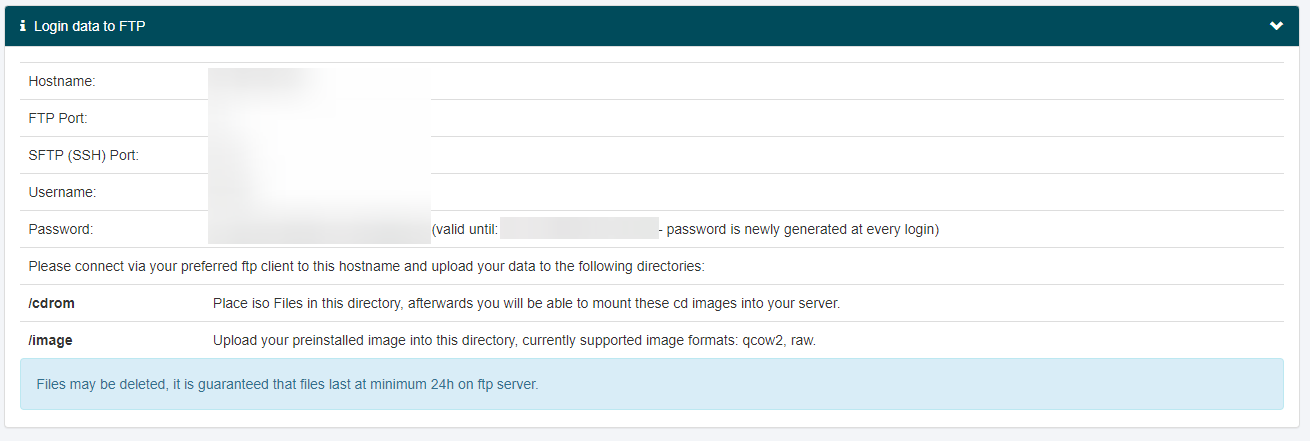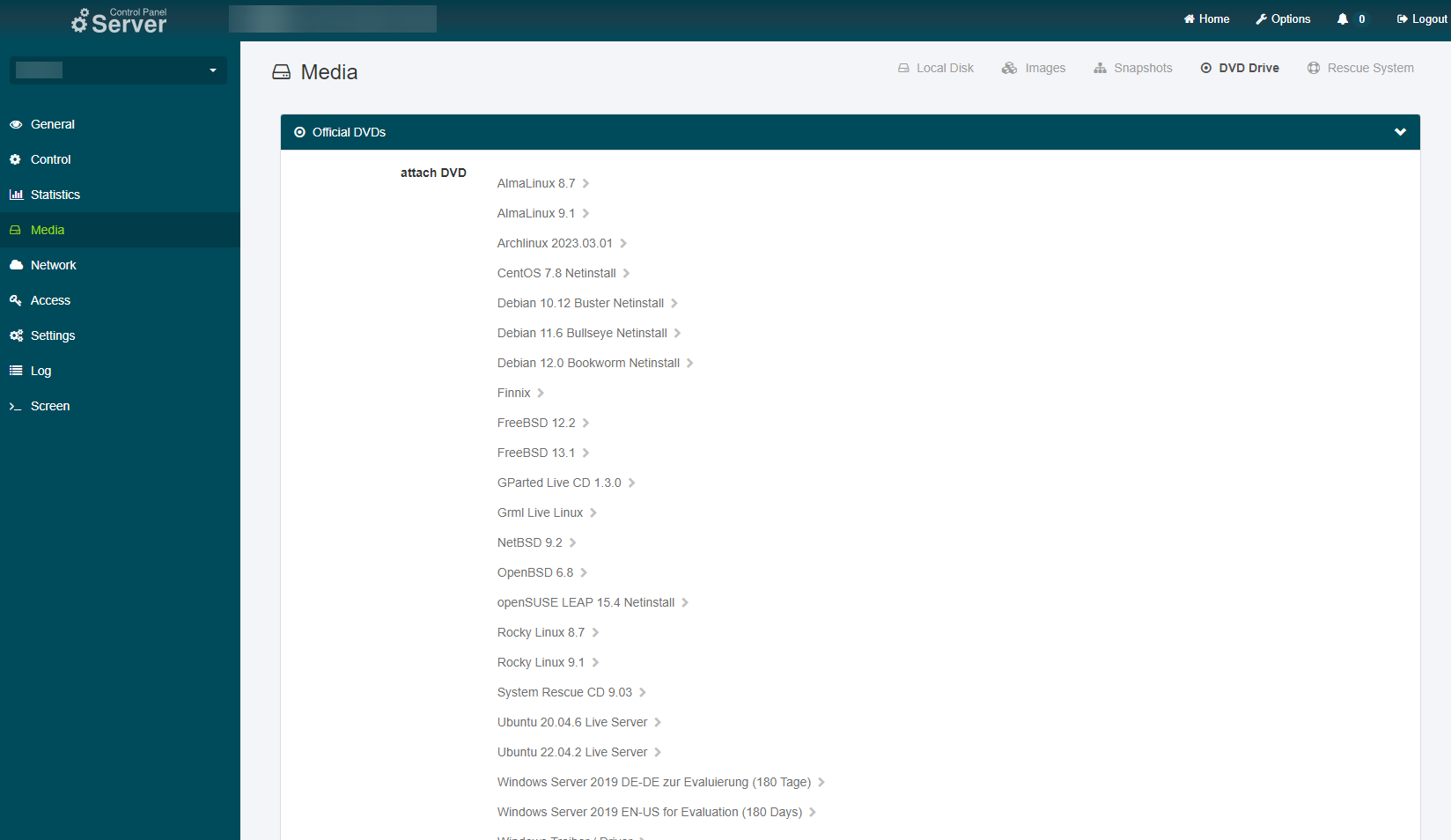netcup wiki
Server

Media
In this section you will find all the management options for the storage provided with your server, alongside the options for accessing various media sources.
The section is divided into five categories named:
You can navigate between these categories by clicking on the corresponding labels.
Local Disk
This section provides you with an overview of the available storage space and allows you to change the driver for the main hard drive used by your server.
| Label | Content |
|---|---|
| Harddrive usage | This is the reserved storage on the host system. Overall, the value may differ from the storage used. If this is the case, please trigger a storage optimization. Encrypted systems are not displayed correctly because of their unused blocks. These cannot be detected by the SCP. |
| Current driver | This setting allows you to change the driver used by your main hard drive. Changes to the storage driver are not trivial! In the worst case, the server can no longer be booted. Please also note that changes to SATA or IDE severely affect other functions such as snapshots. |
Delete Harddrive
This section allows you to permanently erase all contents from the main hard drive used by your server. This will irrevocably delete the server's hard disk. Your server must be stopped for this, and you must first confirm that you are aware of the full consequences of this step by clicking the "Confirmation" slider. If you do not use the "Simple password" option, the SCP password must also be entered.
Upon clicking "Delete hard drive irrepealable", the SCP immediately erases the contents of your server's hard drive and creates a new, completely empty image. After that, you can install a new operating syste
Storage optimization
In this section, you can manually trigger an optimization of your server's hard drive. This is not necessary during normal operation, but it can resolve certain issues you might encounter during use, for example, if you fail to create snapshots because less than 50% of the hard disk space is available.
To trigger optimization, simply click the "Stop server and optimize" button. This will shut down your server, optimize the disk, and then restart your server. If you want your server to remain stopped after optimization, click the "Leave the Server stopped" slider before starting the optimization process.
Depending on your server, this process may take up to 30 minutes. During this entire time, the server is not accessible.
It is not necessary to leave your browser window open during the optimization process.
Images
In this section you will find a wide selection of premade images, but you also have the option to manually provide your own image. Please note that when installing a new operating system, the contents are removed from your server's hard drive.
Official Images
This section provides you with a selection of popular server-focused operating systems that can be installed on your server.
Select the desired operating system by clicking on its name. Next, you will be asked for the "Installation Method". netcup provides some images with additional features, such as an already set up Webhosting capabilities. If you do not need any pre-setup software, "Minimal" is recommended.
Having made your selection, you will be asked to choose between two possible partition layouts. Choosing "One big partition with os as root partition" will give the operating system full access to the entire storage that is available on your server's hard drive. This option is recommended. "Small partition layout for individual use" will only create a partition of sufficient size to install the desired operating system. This option is for users who intend to partition the remaining hard disk space on their own.
After selecting the desired partition layout, you will be prompted to provide your SCP login password. Please remember that this step will delete all data on your server. You can enable the "Send email to me" slider if you wish to receive an email when the SCP has finished installing the new image.
Once the installation process has finished, the SCP will provide you with your server's new root password.
Images Uploaded by Customer
If you have uploaded an image via FTP (see below), you can select it in this section and import it to your server's hard disk.
Login data to FTP
In this section you will find the necessary data to upload your own images via an FTP client of your choice. Images uploaded via this method are accessible for at least 24 hours, but may be deleted after this period. Furthermore, please note that using this method does not allow you to access your server's hard disk directly.
| Label | Content |
|---|---|
| Hostname | IP address used to access your server's image storage |
| FTP Port | Port for accessing the server's image storage via FTP |
| SFTP (SSH) Port | Port for accessing the server's image storage via SFTP (SSH) |
| Username | FTP username for accessing your server's image storage |
| Password | Current FTP password, will be renewed after each login |
| /cdrom | Directory for .iso files, these may be mounted to manually install an operating system. |
| /image | Directory for premade images, currently supported image formats: qcow2, raw |
Snapshots

Due to technical reasons, snapshots can only be created if at least 50% of the disk storage is free.
In this section you can create new snapshots of your server's current state. You can also revert your server to a previous state or export the snapshots locally.
netcup offers its customers two types of snapshots:
| Type | Information |
|---|---|
| Offline Snapshots (recommended) | Offline snapshots are created while the server is powered off. They can be used to back up the server before making major, potentially breaking changes, and can also be exported to your local system. Offline snapshots can also be imported into another netcup server at a later time, allowing easy switching between servers. Note: The hard disk of the new server must be at least as large as the partition used by the backed up server. |
| Online Snapshots | Online snapshots are created while the server is powered on. Online snapshots cannot be exported, and making any file changes while the server is taking an online snapshot may result in irreparable data loss. Online snapshots can also cause your server to be unresponsive for a few minutes. The main advantage of online snapshots is that they also save the state of the server. This means that anything running on the server during the online snapshot can be reverted to the current state. |
Snapshots
You cannot create new snapshots while an .iso image is attached as a cdrom or DVD.
This section provides you with an overview of all previously created snapshots.
To create a new snapshot, first give it a name and description. Then use the drop-down menu to select whether the snapshot type should be online or offline and click the "create snapshot" button on the right.
After creating a snapshot you have several options:
| Label | Option |
|---|---|
| export snapshot | This option is only available for offline snapshots and allows you to export the snapshot to the FTP server, from where you can access it through another netcup server, or use an FTP client of your choice to export the snapshot to your local system. Please note that this process requires traffic ("Snapshot Export"), which can be purchased through the CCP. Depending on your contract, you may have a free export included with your server. |
| revert | This reverts your server to the selected snapshot. |
| delete | This deletes the selected snapshot. This operation cannot be reversed. |
Login data to FTP

Snapshots are compressed by default. Please use 'zstd -d snapshot.raw.zst -o snapshot.raw' to decompress them prior to upload.
This section provides you with the data necessary to upload your own images via an FTP client of your choice. Images uploaded via this method are accessible for at least 24 hours, but may be deleted after this period. Furthermore, please note that using this method does not allow you to access your server's hard disk directly.
| Label | Content |
|---|---|
| Hostname | IP address used to access your server's image storage |
| FTP Port | Port for accessing the server's image storage via FTP |
| SFTP (SSH) Port | Port for accessing the server's image storage via SFTP (SSH) |
| Username | FTP username for accessing your server's image storage |
| Password | Current FTP password, will be renewed after each login |
| /cdrom | Directory for .iso files, these may be mounted to manually install an operating system. |
| /image | Directory for premade images, currently supported image formats: qcow2, raw |
DVD Drive
In this section you will find a wide selection of .iso images, but you also have the option to manually provide your own image. Please note that when installing a new operating system, the contents are removed from your server's hard drive and that manual installation via an .iso file tends to be more complex compared to using images.
Official DVDs
This section provides you with a selection of popular server-focused operating systems that can be installed on your server.
Select the desired operating system by clicking on its name. Then click the "set boot mode to DVD?" toggle so your server can boot from the desired DVD. Type in your SCP login password and click "attach DVD".
Next, you will have to fully power off and power on the server using the "Control" section.
Now, your server will boot from the desired DVD image and you can install the new operating system. This process tends to differ between operating systems.
Own DVDs
If you have uploaded an .iso image via FTP (see below), you can select it in this section and insert it into the DVD drive of your server.
Login data to FTP
This section provides you with the data necessary to upload your own images via an FTP client of your choice. Images uploaded via this method are accessible for at least 24 hours, but may be deleted after this period. Furthermore, please note that using this method does not allow you to access your server's hard disk directly.
| Label | Content |
|---|---|
| Hostname | IP address used to access your server's image storage |
| FTP Port | Port for accessing the server's image storage via FTP |
| SFTP (SSH) Port | Port for accessing the server's image storage via SFTP (SSH) |
| Username | FTP username for accessing your server's image storage |
| Password | Current FTP password, will be renewed after each login |
| /cdrom | Directory for .iso files, these may be mounted to manually install an operating system. |
| /image | Directory for premade images, currently supported image formats: qcow2, raw |
Rescue System
The "Rescue System" can be an invaluable resource for addressing issues, troubleshooting and fixing bugs. It offers you a compact Linux distribution with a multitude of tools that can help you fixing issues, such as problems at booting.

As part of our User Guide you can find an in-depth guide on how to use the Rescue System to troubleshoot issue.





